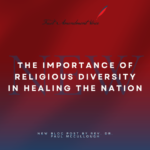 The news about Covid-19, aka the coronavirus, is changing on a daily basis (sometimes hourly). This has proven to be deeply disruptive to many people’s lives around the world as we navigate these unprecedented times like a ship caught in a storm.
The news about Covid-19, aka the coronavirus, is changing on a daily basis (sometimes hourly). This has proven to be deeply disruptive to many people’s lives around the world as we navigate these unprecedented times like a ship caught in a storm.
As we discussed in our first blog post on the pandemic, social distancing restrictions enacted by public officials (with the recommendations of countless medical and public health professionals) carry numerous implications for our freedoms of speech, assembly, press, petition and religion.
In this month’s post, we’re going to explore how religious leaders and institutions around the world have adapted to the restrictions imposed on mass gatherings as the primary means of flattening the curve:
No Mass Gatherings
The First Amendment guarantees citizens’ rights to assemble and freely practice their religion – but what if gathering could lead to devastating health consequences? A major part of many religious practices around the world involves communal gathering, which has created significant challenges during major religious events like Easter and Ramadan.
For instance, Islam’s third-holiest site – Al-Aqsa mosque in Jerusalem – was closed to Muslim worshippers for the fasting month of Ramadan
How Have Faith Leaders Responded?
While most religious institutions have abided by CDC recommendations by switching to remote services, small group meetings, praying times and meditation sessions, there were also several reports of religious leaders defying state-imposed social distancing restrictions that prevented mass gatherings of 5-50 or more (varied from state to state). By the end of March 2020, multiple religious leaders – from many different faiths and sects – had contracted Covid-19 and passed away.
It’s important to note, however, that a vast majority of faith leaders have followed their state or country’s social distancing guidelines and many are busy developing new ways of communicating with their members, as well as positively serving their communities during the outbreak
Different Community Impact
In “normal” times, religious institutions serve as a place for worship, congregation, spiritual and social connection; in “corona” times however, these institutions are legally (and, some argue, morally) prohibited from engaging in many activities and services they normally fulfill for members and the wider community.
Fortunately, faith leaders from all over have come up with innovative ways to still make positive impacts on their communities, including:
- The Jewish Council for Public Affairs (JCPA) put out a letter in support of Chinese and Chinese-Americans who were targeted due to misinformation about the coronavirus back in February. In April, several Chinese-American groups came together to return the support by donating thousands of personal protective equipment to Jewish groups around the U.S.
- A church in Ohio redirected its Easter events budget to pay off $1.2 million in medical debt for members of the community.
- Muslims delivered meals for needy individuals and families for the predawn meal during Ramadan.
- Catholic churches in India distributed food and supplies to the nation’s refugees and other marginalized groups.
- Orthodox Jewish groups donated vans of food, toiletries and face masks to their local Latinx community after it was particularly hard-hit by the outbreak.
Will These Changes Persist After the Pandemic?
Many are hoping religious services will go back to normal after the pandemic ends (or at the very minimum, social distancing restrictions are heavily relaxed), but there will likely remain some long-lasting consequences for religious institutions after 2020.
Starting with the not-so-great news: many religious institutions and groups are struggling financially during the pandemic. Many are operating on a fraction of their usual budgets due to lower-than-anticipated funds coming in during weekly services, and even the tech-savvy organizations with well-designed, easy-to-navigate donations pages are struggling due to their members’ unwillingness or inability to send electronic donations.
On a more positive note, the innovations developed now could help religious leaders run their organizations more efficiently in terms of financial management, technological tools for reaching new and current members alike, and adaptability in case there’s ever another pandemic or natural disaster or other reason preventing everyone from coming together to practice their faiths.
There’s no telling what may happen in the coming months. Public health is extremely important, and we must continue to advocate for our First Amendment freedoms while also doing our best to protect our friends and neighbors. If you are interested in this topic and want to learn more, we held a virtual Town Hall on this, which you can replay here.





